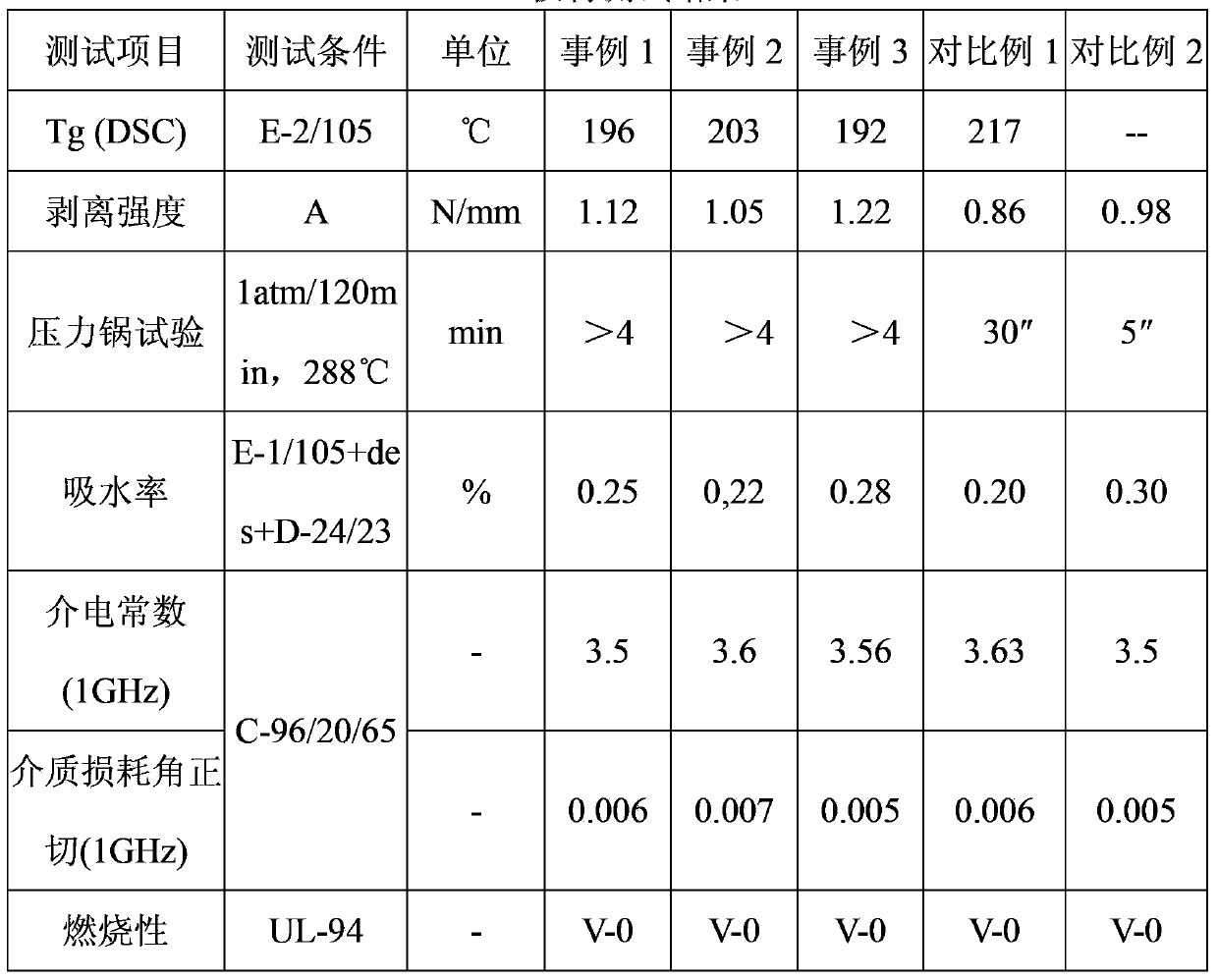Cyanate ester composition and method used for preparing copper-clad plates by cyanate ester composition
A technology of cyanate ester and composition, which is applied in the field of preparing copper clad laminates, can solve problems such as voids and white spots, poor adhesion between insulating materials and copper foil, and low fluidity of prepregs, so as to improve compatibility , the effect of excellent dielectric properties
- Summary
- Abstract
- Description
- Claims
- Application Information
AI Technical Summary
Problems solved by technology
Method used
Image
Examples
Embodiment 1
[0034] Add 100 parts of polyphenylene ether, 9.5 parts of bisphenol A, and then add 150 parts of toluene into a four-neck flask, heat to 100°C, and stir with a stirring bar until it dissolves and becomes transparent. 4 parts of benzoyl peroxide were dissolved in toluene, and dropped into the reaction vessel dropwise, and the reaction continued for 100 minutes. Nitrogen gas flow was maintained throughout the process. When the reaction is over, the product is precipitated with methanol and filtered to obtain a low-molecular-weight polyphenylene ether capped with phenolic hydroxyl groups.
[0035] Select 65 parts of the above polyphenylene ether, add 75 parts of toluene, stir and heat to 100°C until it is completely dissolved, add 35 parts of dicyclopentadiene monomer, and stir until the solution is uniform. Then add 100 parts of cyanate ester and 0.12 parts of organometallic salt catalyst while keeping the solution temperature at 97-103°C. After all the solutions are added, the...
Embodiment 2
[0037] Add 100 parts of polyphenylene ether, 9.5 parts of bisphenol A, and then add 150 parts of toluene into a four-neck flask, heat to 100°C, and stir with a stirring bar until it dissolves and becomes transparent. 4 parts of benzoyl peroxide were dissolved in toluene, and dropped into the reaction vessel dropwise, and the reaction continued for 100 minutes. Nitrogen gas flow was maintained throughout the process. When the reaction is over, the product is precipitated with methanol and filtered to obtain a low-molecular-weight polyphenylene ether capped with phenolic hydroxyl groups.
[0038] Select 80 parts of the above polyphenylene ether, add 65 parts of toluene, stir and heat to 100°C until it is completely dissolved, add 20 parts of styrene monomer, and stir until the solution is uniform. Then add 100 parts of cyanate ester and 0.08 parts of organometallic salt catalyst while keeping the solution temperature at 97-103°C. After all the solutions are added, the solution ...
Embodiment 3
[0040] Add 100 parts of polyphenylene ether, 9.5 parts of bisphenol A, and then add 150 parts of toluene into a four-neck flask, heat to 100°C, and stir with a stirring bar until it dissolves and becomes transparent. 4 parts of benzoyl peroxide were dissolved in toluene, and dropped into the reaction vessel dropwise, and the reaction continued for 100 minutes. Nitrogen gas flow was maintained throughout the process. When the reaction is over, the product is precipitated with methanol and filtered to obtain a low-molecular-weight polyphenylene ether capped with phenolic hydroxyl groups.
[0041] Select 50 parts of the above polyphenylene ether, add 65 parts of toluene, stir and heat to 100°C until it is completely dissolved, add 100 parts of styrene monomer, and stir until the solution is uniform. Then add 100 parts of cyanate ester and 0.12 parts of organometallic salt catalyst while keeping the solution temperature at 97-103° C. After all the solutions are added, the solutio...
PUM
 Login to View More
Login to View More Abstract
Description
Claims
Application Information
 Login to View More
Login to View More - R&D
- Intellectual Property
- Life Sciences
- Materials
- Tech Scout
- Unparalleled Data Quality
- Higher Quality Content
- 60% Fewer Hallucinations
Browse by: Latest US Patents, China's latest patents, Technical Efficacy Thesaurus, Application Domain, Technology Topic, Popular Technical Reports.
© 2025 PatSnap. All rights reserved.Legal|Privacy policy|Modern Slavery Act Transparency Statement|Sitemap|About US| Contact US: help@patsnap.com



